Erith Council Tramways
History
Erith Urban District Council opened its short (4.7 miles), standard-gauge tramway on the 26th August 1905; it was built under powers — the Erith Tramways and Improvement Act, 1903 — obtained on the 14th August 1903.
The main line ran westwards from Erith to Abbey Wood on the municipal boundary, and southwestwards to Northumberland Heath (again on the municipal boundary), and southwards to Northend, the latter line being only half a mile long. The initial services were worked using 14 tramcars, another two small demi tramcars following in 1906 in an attempt to stem the losses on the Northend branch.The council had hoped that London County Council Tramway's planned line to Plumstead would be extended to Abbey Wood, giving access to traffic to and from London; however, whilst the LCCT initially made some positive noises, hopes of inter-running were ultimately to prove forlorn. It seems likely that the LCCT was never really interested in through running to/from Erith, and even when its line to Abbey Wood was completed in 1908, it continued to come up with various excuses for not physically connecting its tracks to those of Erith. The connection was not in fact made until late 1933, when both tramways were part of the London Passenger Transport Board system.
At the other end of the system, things initially looked considerably brighter, with Bexley Heath Urban District Council readily agreeing to a connection between their existing line to Northumberland Heath and Erith's. This proved, however, to be a false dawn, with Bexley unexpectedly declining Erith's approach to instigate through running, a rebuff which presaged a decade of petty squabbling between the two councils. An agreement for through running of Erith cars to Bexleyheath was first reached in 1908, nearly three years after the tracks had been connected, with services commencing on the 26th July 1908. All was not well, however, with Erith feeling that they were paying far too much to run their cars through, so the service was terminated exactly one year later. Erith's decision to terminate the service was no doubt reinforced by the continual financial losses it was suffering, particularly on the Northend route, which should probably never have been built, and which was to close for good on the 31st August 1910, barely five years after it had been constructed.
The on/off service to Bexleyheath was resumed on the 26th July 1910 after Bexley accepted a revised offer from Erith, but was terminated once again on the 25th July 1914, this time by Bexley, who felt that Erith were not paying enough. Matters now took a more serious turn due to the Great War, and the importance of munitions manufacture in the area. The latter was being hampered by workers constantly having to change cars at the municipal boundary, and this reached the attention of the War Office in December 1914. Despite a polite request to sort their differences out, Erith astoundingly saw fit to issue a 'take it or leave it' ultimatum to two approaches from Bexley, with the latter refusing to accede. By October 1915, the War Office had clearly had enough, and a meeting took place with the Ministry of Munitions and an independent tramway arbitrator — this finally did the trick, through-running being reinstated towards the end of the month, the final agreement differing only by half a pence per mile from that terminated 18 months earlier.
The war did at least move the tramway into profit, but the end of the conflict and with it, the heavy loadings of war workers, heralded a return to the old status quo. Infrastructure renewal and competition from buses exacerbated an already dire financial situation, so it was probably with some relief that the council handed over their charge (and its continuing losses) to the London Passenger Transport Board on the 1st of July 1933. The LPTB lost no time in converting the loss-making system to trolleybus operation, the last tram running over former Erith metals 15 months later on the 9th November 1935.
Uniforms
In the early years of the tramway, conductors and motormen wore single-breasted jackets with five buttons (plain with a scalloped rim; see link), two breast pockets, epaulettes and stand-up collars; by analogy with later photographs, the bearer's left-hand side probably bore an employee number (in individual metal numerals), with the right-hand side bearing metal system initials, 'E C T'. Anecdotal evidence suggests that the insignia were brass, though this is by no means proven. The tensioned-crown peaked caps bore script-lettering grade badges — 'Motorman' or 'Conductor' — above which a small badge, comprising the Prince of Wales feathers and motto, was worn.
By the time of the Great War, a switch had been made to double-breasted lancer-style tunics with five pairs of buttons (narrowing from top to bottom), epaulettes and stand-up collars; the latter carried an employee number on the left-hand side and 'E C T' initials on the right-hand side. The tunics were a very dark, navy-blue serge. A further change in the style of the jacket was made after the war, probably in the early 1920s, and though still double-breasted with epaulettes, it now had high fold-over collars and lapels that could either be worn open or buttoned up; the collars continued to carry the same badges as the tunics they replaced. Although these new jackets were not in a true lancer style, the jacket button pairs did narrow slightly from top to bottom.
Conductors and motormen were also issued with double-breasted greatcoats with high fold-over collars and epaulettes; it is currently unclear what insignia, if any, these carried.
Motormen and conductors always appeared in service wearing enamel Public Carriage Office licence badge; these were issued by the Metropolitan Police (see link).
During the first two decades of operation, inspectors wore single-breasted jackets with hidden buttons (or more likely a hook and eye affair) and stand-up collars; the latter carried the grade — 'Inspector' — on both sides, in embroidered script lettering. Inspectors’ peaked caps were also of the tensioned-crown variety; they had a braided peak and an elaborate black hat band, which almost certainly bore the grade — 'Inspector' — in embroidered script lettering. At some point in the early 1920s, inspectors' jackets were changed to a more modern double-breasted style with four pairs of buttons and lapels; the collars and the caps bore the same insignia as previously. Two staff photographs show an individual who is wearing a very similar uniform to the inspectors, but whose collar and cap insignia appear to bear system initials, 'E C T'. It is unclear what grade this individual held, though he may well have been a chief inspector.
In common with the vast majority of British tramways, Erith employed female staff during the Great War to replace tramwaymen lost to the armed services. These ladies were employed from April 1916 onwards, and were issued with distinctive, short, tailored tunics with six pairs of buttons (narrowing from top to bottom) and high, fold-over collars; the latter bore an employee number (on the left-hand side) and 'E C T' initials (on the right-hand side). A long matching skirt was also provided. The peaked caps had a wide, tensioned crown; they bore script-lettering grade badges, though seemingly without the small Prince of Wales feathers badge that the men usually wore.
Further reading
For a history of Erith's tramways, see: 'Tramways of Woolwich and South-East London' by Southeastern; Light Railway Transport League (1963).
Images
Motormen and conductors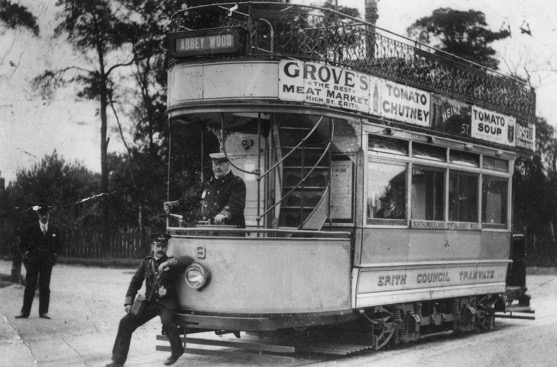
A conductor and a motorman with Tramcar No 9 at Northumberland Heath in early apple green livery— photo undated, but probably taken in the mid-Edwardian era. Author's Collection.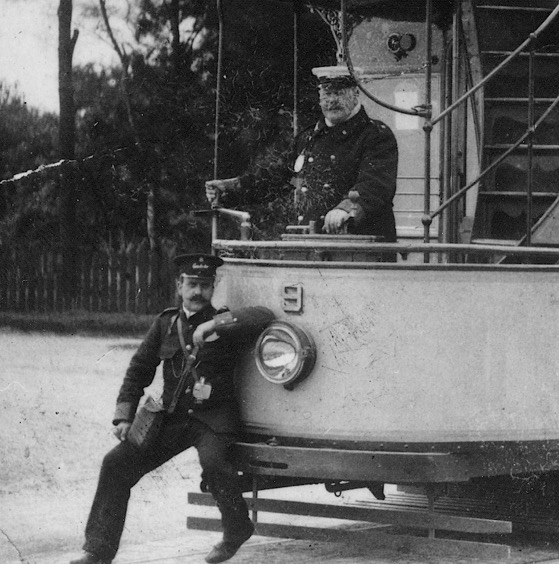
An enlargement of the above photograph showing the crew; the conductor is clearly wearing a small badge above his script-lettering grade badge. Both men are also wearing PCO licence badges issued by the Metropolitan Police (see link). 
A rare portrait of an Erith Council Tramways motorman — photo undated, but probably mid-to-late Edwardian. Author's Collection.
An enlargement of the above photograph showing details of the uniform insignia, including the 'E C T' collar badges, the plain scalloped-rim buttons, and the Prince of Wales feathers cap badge. 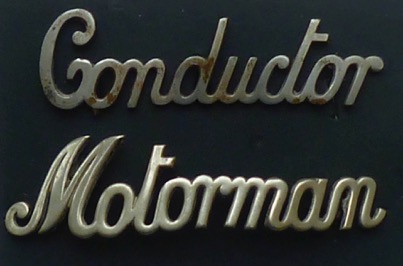
Standard off-the-shelf script-lettering grade badges of the type worn by Erith Council Tramways staff — nickel. It is currently unclear whether the badges issued by Erith Council Tramways were brass or nickel. Author's Collection.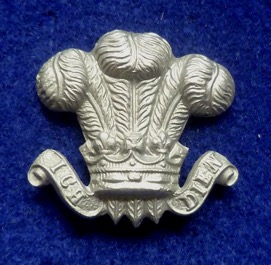
A Prince of Wales feathers badge, possibly the same type used by Erith Council Tramways — nickel. Badges of this general type exist in many different forms, and it is currently impossible to say whether this is the exact type used by Erith; however, it was identified as 'Erith Council Tramways' in an old tramway badge collection, so may possibly be correct. The badge was almost certainly a stock item used by numerous organisations, rather than one made expressly for Erith Council. Author's Collection.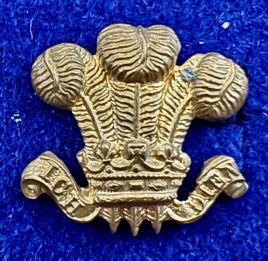
A Prince of Wales feathers badge, possibly the same type used by Erith Council Tramways — brass. It is currently unclear whether Erith Council Tramways uniforms bore nickel or brass insignia. Author's Collection.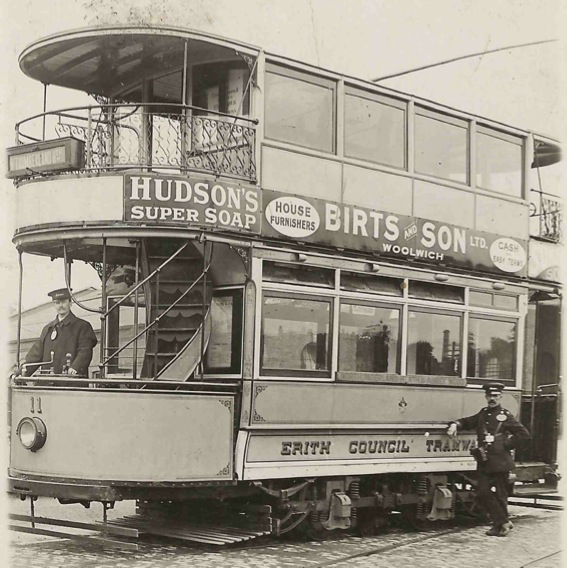
The crew of ECT Tramcar Number 11 — photo undated, but probably mid-Edwardian judging by the good condition of the tram. Although the Prince of Wales feathers cap badge seen in other photos is not in evidence, this is probably because it has been obscured by the rain covers that both men are wearing on their caps. With thanks to Richard Rosa.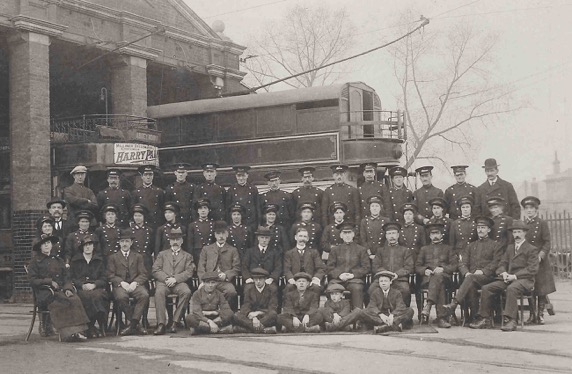
Erith Council Tramways staff photograph — undated, but almost certainly taken during the Great War given the large number of female employees. The car in the background would appear to be No 19, an ex-Hull City Tramways vehicle purchased in 1916. With thanks to Richard Rosa.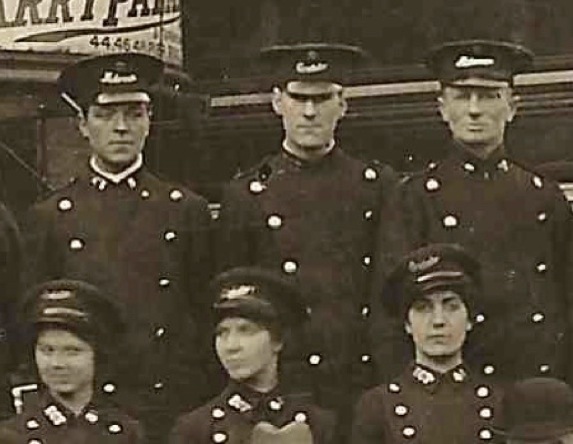
An enlargement of the above photograph showing two motormen and a conductor (back row), all of whom are wearing a Prince of Wales feathers badge above their grade badges, in contrast to the ladies below them, who are not. With thanks to Richard Rosa.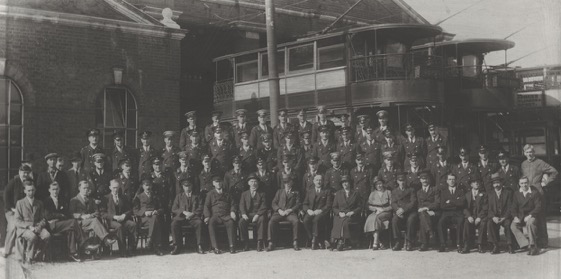
A staff photograph taken at Walnut Tree Road Depot in 1923 by 'Thomas' of Belvedere. Author's Collection.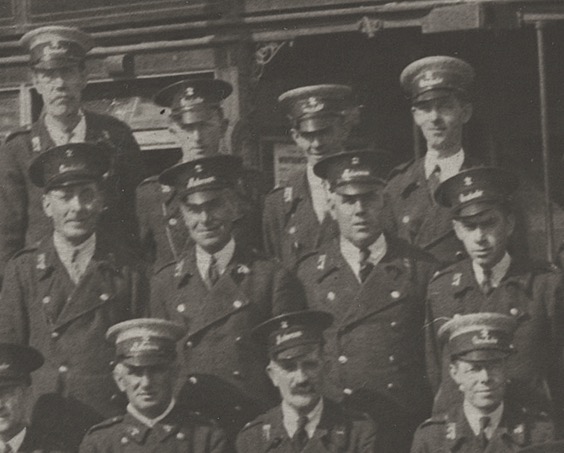
An enlargement of the above photograph showing several motormen and conductors, all of whom are wearing a new style of jacket issued in the early 1920s; although still double-breasted, they could now be worn open necked to reveal the shirt and tie, or buttoned up.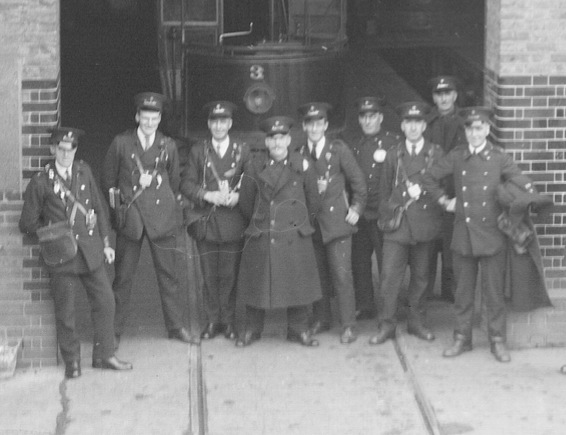
A group of ECT conductors and motormen pose at Walnut Tree Road tram depot — photo undated, but probably taken in the late 1920s or early 1930s. With thanks to the National Tramway Museum.
Senior staff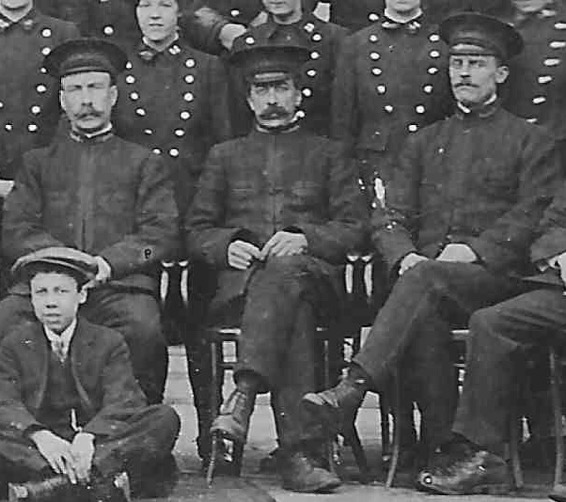
An enlargement of the Great War staff photograph above showing three inspectors. Whilst three of the inspectors have the grade — 'Inspector' — embroidered on both collars, the man on the left appears to have embroidered system initials, 'E C T'. It is possible that he was the chief inspector.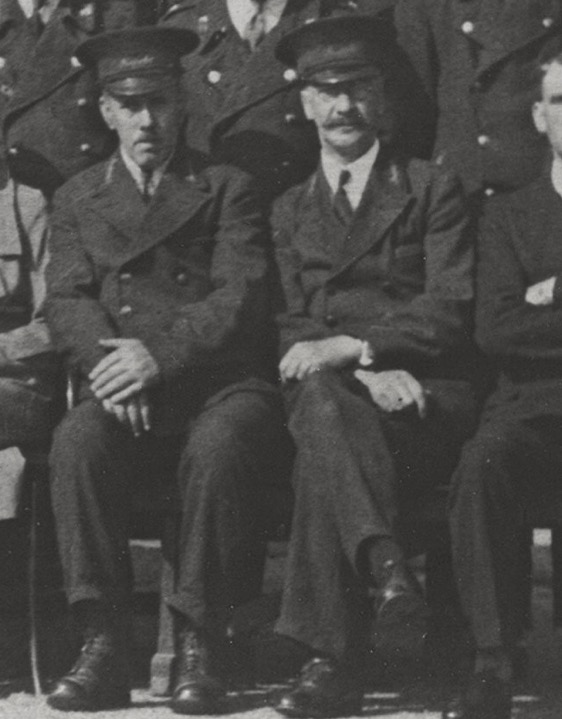
An enlargement of the 1923 depot photograph above showing two inspectors in their double-breasted jackets and tensioned-crown peaked caps, both the collars and the caps bear embroidered grade insignia. Author's Collection.
Another blow-up of the above photograph, this time showing an individual who may possibly by the chief Inspector. Although the uniform is similar to that worn by the inspectors in the same photograph, the subject's jacket collars and hat band would appear to bear embroidered system initials, 'E C T'. He is almost certainly the same man who is wearing similar insignia in the Great War photograph above.
Female staff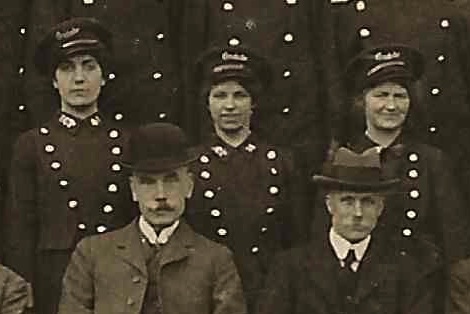
An enlargement of the Great War staff photograph above showing three conductresses in their distinctive tailored, lancer-style tunics, and wide-crown peaked caps.